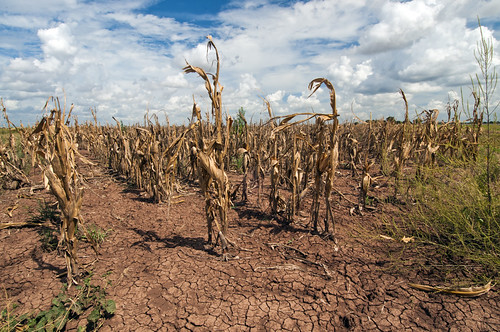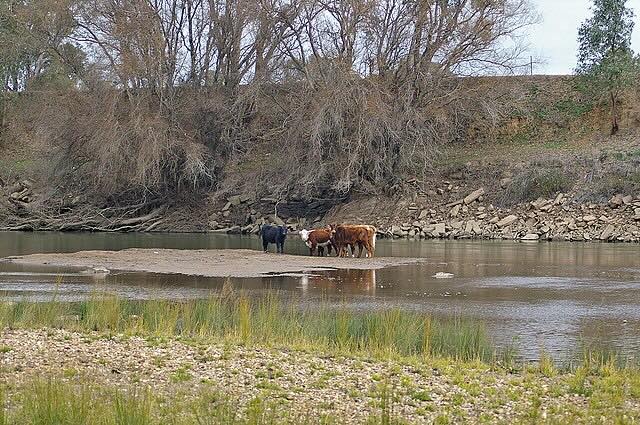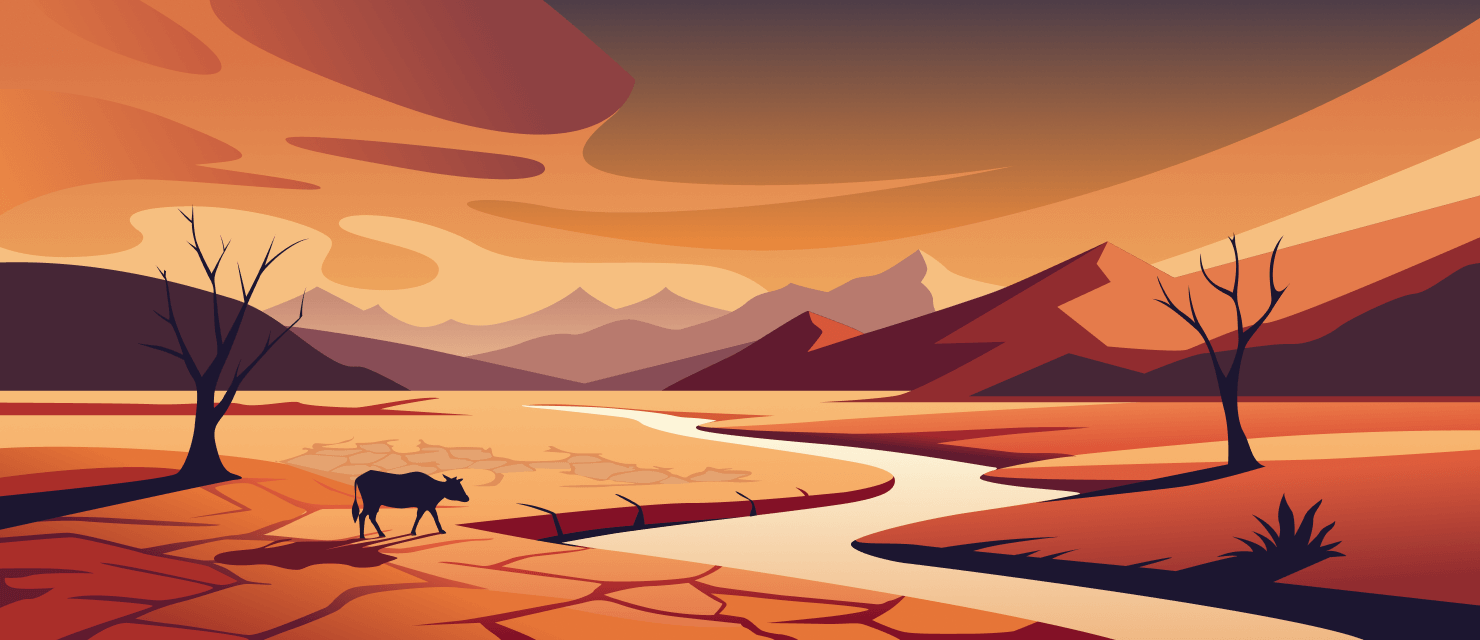Droughts, the silent yet formidable force of nature, have a profound impact on our environment, economy, and society. As climate change intensifies, understanding the causes, consequences, and potential solutions to droughts becomes increasingly critical. In this blog post, we explore how droughts are defined, measured, and monitored, as well as examine their far-reaching impact on our world.
What Is a Drought?
A drought is a period of unusually dry weather, when there is not enough water for the needs of people, plants, and animals. They can cause crop failures, water shortages, wildfires, and health issues. However, the drought definition varies across regions, considering factors like soil moisture, streamflow, and reservoir levels. There are several types of drought - meteorological, agricultural, hydrological, and socioeconomic, each posing unique challenges.
 Image source: Wikipedia
Image source: Wikipedia
Types of Drought
This type of drought is typically the first stage in a drought event, leading to decreased soil moisture, reduced water levels in rivers and lakes, and dry conditions that can increase the risk of wildfires. Agricultural drought affects crop production, livestock, and water availability for irrigation. It occurs when there is not enough soil moisture to support plant growth, leading to stunted crops, reduced yields, and increased competition for water resources. Hydrological drought refers to low water availability in rivers, reservoirs, and groundwater. This type of drought can have long-lasting impacts on ecosystems, water supply for drinking and irrigation, and hydropower generation. Socioeconomic drought occurs when the impact of a drought extends beyond the physical environment to affect human populations. This can include food shortages, loss of income for farmers and agricultural workers, increased food prices, and migration of people from affected areas.
Drought Monitoring Techniques
Precise measurement and monitoring of drought conditions are essential for effective drought mitigation. Scientists use various indices, such as the Palmer Drought Severity Index (PDSI) and the Standardized Precipitation Index (SPI), to quantify the severity and duration of droughts.
The PDSI is a number from -10 to +10 that shows the extent of the wet or dry weather. If the number is negative, it means there is a drought. If the number is positive, it means there is a lot of rain.
| PDSI value | Classification |
|---|---|
| 4.0 or more | extremely wet |
| 3.0 to 3.99 | very wet |
| 2.0 to 2.99 | moderate wet |
| 1.0 to 1.99 | slightly wet |
| 0.5 to 0.99 | incipient wet spell |
| 0.49 to -0.49 | near normal |
| -0.5 to -0.99 | incipient dry spell |
| -1.0 to -1.99 | mild drought |
| -2.0 to -2.99 | moderate drought |
| -3.0 to -3.99 | severe drought |
| -4.0 or less | extreme drought |
Table source: Wikipedia
The SPI is a new drought index that only uses rain data. It’s a number that shows how likely it is to rain for any time period. Some processes are fast because of the weather, like farming on dry land, and the period for these variations is one or two months. Other processes last longer, like the changing water levels in wells, ponds, and small rivers, with the time scale being several months. Finally, some processes are very slow, like the amount of water in big reservoirs, aquifers, or lakes, and this can last several years.
Causes of Drought
Here’s what can lead to a drought:
- Climate change. Human activities, especially the burning of fossil fuels, contribute to climate change, altering precipitation patterns and increasing the frequency and intensity of droughts.
- Natural variability. Natural climate phenomena, like El Niño and La Niña, influence weather patterns globally, leading to either dryness or increased precipitation.
- Land use changes. Deforestation, urbanization, and changes in land cover can disrupt local and regional water cycles, contributing to dry conditions.
Worst Droughts in History
Throughout human history, there have been many cases of severe and prolonged droughts that have caused widespread suffering and devastation.
Dust Bowl (1930s, United States)
A combination of prolonged dry period, poor land management practices, and economic depression led to the Dust Bowl. This severe weather event caused widespread soil erosion and crop failures across the Great Plains.
Sahel Drought (1968-1974, Sub-Saharan Africa)
Prolonged drought in the Sahel region led to food shortages and famine. Millions of people in countries like Mali, Niger, and Burkina Faso were affected by drought.
Australian Millennium Drought (1997-2009, Australia)
A protracted period of low rainfall and high temperatures impacted water supplies, agriculture, and ecosystems, prompting the development of innovative water management strategies.
 Image source: Bidgee, CC BY 3.0, via Wikimedia Commons
Image source: Bidgee, CC BY 3.0, via Wikimedia Commons
Effects of Drought
Droughts impact not only the weather and climate but also the economy and society.
- Environmental impact. Reduced water availability harms ecosystems, leading to habitat loss, biodiversity decline, and increased vulnerability to wildfires.
- Economic implications. Agriculture, a sector highly dependent on water, suffers from crop failures and decreased productivity during drought. Water scarcity also impacts industries, affecting energy production, manufacturing, and tourism.
- Social challenges. Droughts pose threats to human health, exacerbating waterborne diseases and food insecurity. Migration and conflict may arise as communities compete for dwindling water resources.
 Image source: © Tomas Castelazo, www.tomascastelazo.com / Wikimedia Commons
Image source: © Tomas Castelazo, www.tomascastelazo.com / Wikimedia Commons
Drought Solutions
To cope with and prevent future droughts, we need to use different strategies that can help us save water, plan ahead, and fight climate change. Organizations like the U.S. National Drought Mitigation Center offer the following solutions:
- Water conservation and management. Implementing efficient water use practices, adopting modern irrigation techniques, and investing in water infrastructure enhance resilience to drought.
- Diversification of water sources. Developing alternative water sources, such as rainwater harvesting, recycling treated wastewater, and exploring desalination, can reduce reliance on traditional sources.
- Early warning systems. Advanced monitoring and forecasting tools help authorities anticipate and prepare for droughts, allowing for timely interventions and resource allocation.
- Climate change mitigation. Reducing greenhouse gas emissions is crucial for curbing the long-term impacts of climate change, including more severe and frequent droughts.
Conclusion
Droughts represent a complex challenge with widespread implications for the environment, economy, and society. We need to act fast and use new technologies to deal with climate change. If we know why droughts happen and how they affect us, we can work together to make a better future.






